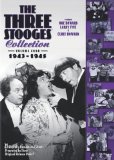| Reviews & Columns |
|
Reviews DVD TV on DVD Blu-ray 4K UHD International DVDs In Theaters Reviews by Studio Video Games Features Collector Series DVDs Easter Egg Database Interviews DVD Talk Radio Feature Articles Columns Anime Talk DVD Savant Horror DVDs The M.O.D. Squad Art House HD Talk Silent DVD
|
DVD Talk Forum |
|
|
| Resources |
|
DVD Price Search Customer Service #'s RCE Info Links |
|
Columns
|
|
|
Three Stooges Collection - Volume Four: 1943-1945, The
Author's Note: I'll be stepping in for Stuart Galbraith IV for this volume of the Stooges shorts; he'll be back for the remaining releases.
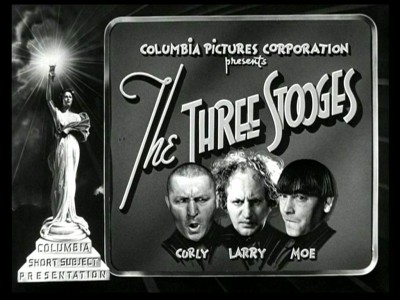
Columbia Pictures and Sony have released The Three Stooges Collection - Volume Four: 1943-1945, gathering together 21 shorts from what the back of the DVD box claims are the "final years of what has become regarded as the high point in their career - their Golden Age." Fans who have rejoiced at the respect finally accorded the Stooges with these beautifully presented DVDs will no doubt look at this release with a somewhat wistful eye, considering it's the final time that beloved Stooge, Curly Howard, performs at a level close to his peak years. A series of increasingly damaging strokes - along with a heavyweight lifestyle including excessive drinking and partying - would soon rob the comedian of his manic energy, his rather remarkable physical grace, and his superb comedic timing, the first effects of which are distressingly noticeable in the last few shorts of this collection.
Fans of the Stooges need no justification for their art (nor do they probably need yet another testimonial to their popularity), so I won't belabor the point that I consider The Three Stooges (with Curly and later shorts with Shemp) true comedic geniuses who specialized in a brand of knockabout, baggy pants slapstick that nobody ever came close to duplicating, in either sustained effort (the Stooges consistently knocked out one winner after another for decades), or in effectiveness. The simple fact that the Stooges are still around, introduced to new appreciative generations time and time again while other seminal comics slowly fade into the background, says something significant about their work, their art. I understand that there are serious critics (as well as snooty filmgoers) who deride the use of the word "art" in conjunction with The Three Stooges, but how else can you describe an aesthetic work that still connects so directly with audiences (audiences who are vastly different in their outlooks on life, on society, on politics, than the Stooges' original audiences), on such a primal, elemental level? Is that not the very definition of "art?"
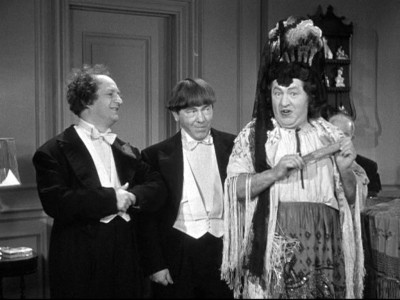
Logically, there should be no reason why these relatively primitive short-subject films would still appeal to modern moviegoers. The consistently reoccurring themes embraced by the Stooges - horrific violence for its own sake, punitive punishment for the slightest infraction of social etiquette, crude, base levity, such as throwing a pie at someone, the celebration of stereotypes for comedic effect - would seem to be anathema to everything our disturbingly restrictive, one-sided P.C. pop culture holds dear. Other vintage comedians whose acts are relatively "safe" within the confines of our hijacked pop culture, are falling fast off the national radar - if they haven't already disappeared altogether. While once-great big-screen comedy talents like Hope and Crosby, Abbott and Costello, Martin and Lewis, the "Our Gang" performers - welcomed, endlessly repeated visitors to the TV sets of kids from my generation and before - are now slipping off into pop culture oblivion, popping up occasionally on round-the-clock movie channels, or on low-selling DVDs, the Stooges march on, never really leaving heavy syndication on TV since the 1950s, and until just last year, still regularly featured on basic cable. What's the appeal, after all these years?
Well, as Jackie Gleason brilliantly observed when asked why The Honeymooners were still being endlessly replaying, "Because they're funny." It may seem painfully evident to Stooge fans, but I don't think this obvious - yet strangely elusive - point is made enough with the Stooges. How can anyone actually define what is and isn't funny? Something just is, or it isn't, and the Stooges are paralyzingly funny...to me, and to millions and millions of fans. One thing is for certain when discussing the appeal of the Stooges: there's no middle ground. People seem to either adore them, or despise them. I don't know if there are adequate words to describe the mounting horror/delight in a viewer in seeing the utterly careless disregard for human suffering that occurs in the single most violent Stooge short ever produced, They Stooge to Conga (included in this collection), but I do know the absolutely visceral effect it has on newcomers to it (my three sons were...floored by the effect). That is art, regardless of its pedigree, regardless of its "correctness."
As to these particular shorts in The Three Stooges Collection - Volume Four: 1943-1945 (I'll comment on each one below), taken as a whole they represent the Stooges just past the tipping point of their peak, with the surreally violent, transcendentally brutal They Stooge to Conga opening the two-disc set, and the depressing, sad spectacle of Curly Howard in full decline in If a Body Meets a Body in the next-to-last offering. In between are many titles thoroughly familiar to Stooge fans who grew up on their endless repeats on afternoon and Saturday morning TV, with particular fan favorites such as Dizzy Detectives, Spook Louder, Higher Than a Kite, I Can Hardly Wait (a particular favorite of mine), Phony Express, A Gem of a Jam, Cash Goes the Hash ("Jeepers, creepers! What a night!"), Busy Buddies, Idle Roomers, Gents Without Cents, the bizarre No Dough Boys, and the oft-repeated Idiots Deluxe holding their own with the Stooges' better war-period shorts. Obviously, WWII figures prominently as subject matter in many of these shorts, and along with two appearances by expert farceur Dudley Dickerson, the numerous depictions of Japanese soldiers here should probably be noted for anyone too sensitive and easily offended by exaggerated racial stereotypes limned for comedic effect.
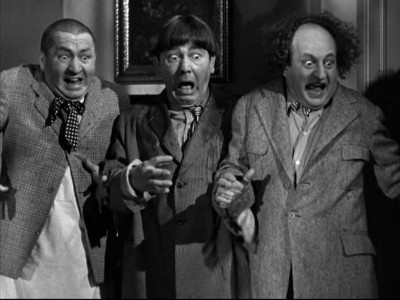
DISC ONE:
1943
They Stooge to Conga (January 1, 1943)
"Handymen Larry, Moe and Curly encounter the axis of evil when they are called on to fix the doorbell of an enemy spy's hideout, where they discover a secret war room."
Almost spookily violent, The Stooge to Conga rightfully carries the honor of being the most mayhem-soaked Stooge short by legions of fans, and watching it for the first time can be a paralyzing moment of incredulous awe at the Stooges' sophisticated orchestration of brutal carnage in service of laughs. This may be the perfect distillation of the Stooges' primal, elemental appeal, where an actual plot is most decidedly secondary to a series of increasingly violent encounters between the Stooges, until both the audience and the Stooges themselves can hardly believe how far events have gone a field of the bounds of civilized society. Directed by Del Lord, and written by Monte Collins and Elwood Ullman, They Stooge to Conga expertly builds from the Stooges' first encounters as door-to-door salesmen, to the increasingly chaotic events inside the spy's house, where they try and repair a doorbell. Certainly the scene where Moe endures three punctures to his skull, ear and eye from a climbing spike worn by Curly (punctuated by a hilarious, sucking "ker-splunk" sound each time the spike is pulled out), rates as a Top Five moment in the Stooges' pantheon. A beautifully surreal nightmare of hilarious violence.
Dizzy Detectives (February 5, 1943)
"When the Stooges are assigned to crack a case involving a burgling gorilla, the novice detectives find their trail leads them to an antiques shop and the real crooks."
Despite the odd opening segment, with stock footage lifted from the Stooges' 1935 Pardon My Scotch (where the boys look considerably younger), once the Stooges start running around the abandoned store, dodging the insane gorilla, it's one of the better Stooges' "spookem" shorts. That's a hell of a fall that Moe takes on that table from the earlier stock footage (pratfalls that would become increasingly rare by the actual Stooges as time wore on), while the swishing-cat-tail-under-the-rocking-chair bit is a classic. Equally memorable is Curly's bit where his hat falls on his foot, and he keeps thinking it's someone watching him - nicely directed by Jules White (with a screenplay by Felix Adler). The roaring, decapitated ape head at the film's end was always a favorite of mine.
Spook Louder (April 2, 1943)
"A mysterious pie-thrower is the least of the Stooges' worries when they are hired to guard an inventor's haunted mansion from spies, who arrive disguised as monsters."
A big favorite with kids because of its funny/scary scenes, Spook Louder has one of Curly's more memorable bits where he tries to elude a balloon with a laughing face painted on it, that's been attached to his rear end. Curly's screams of terror whenever the balloon barely touches him, are priceless. This is the Curly that fans absolutely love, with faultless timing and a natural comedic gift that elevated him to the forefront of the team. Moe has a great bit, too (perhaps "borrowed" by Mel Brooks for his Young Frankenstein?) when he gets caught in a revolving bookcase. Funny script by Clyde Bruckman.
Back From the Front (May 28, 1943)
"Adrift at sea, merchant marines Larry, Moe and Curly climb aboard a nearby ship and find themselves trapped with the enemy and fighting for their lives."
A not-terribly memorable Stooges short, Back From the Front has a couple of good lines (I like their names: Dinky, Blinky and Stinky), while Moe's bit as Hitler (which he had already performed in the superior You Natzy Spy! and I'll Never Heil Again) is funny - if getting familiar by now. Much running around, but too bogged down in the espionage plot to get much traction with the Stooges' target brand of mayhem.
Three Little Twirps (July 9, 1943)
"If you can't bet 'em, join 'em. When the Stooges get caught scalping circus tickets, their only option besides jail is to be part of an act involving a spear-thrower."
A fun, snappy mid-level short from the Stooges, with the opening billboard sequence notable for Moe getting a stick repeatedly in the face. The circus sequence doesn't come alive until Larry and Curly get in that pantomime horse (there's a good cameo by silent screen great, Chester Conklin) - always a good bit.
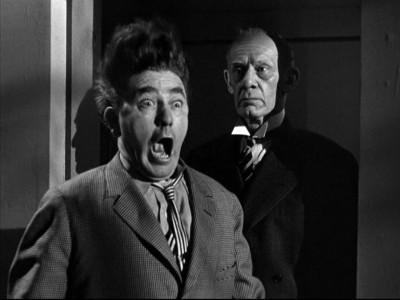
Higher Than a Kite (July 30, 1943)
"When the Stooges are assigned to crack a case involving a burgling gorilla, the novice detectives find their trail leads them to an antiques shop and the real crooks."
Amusing Stooge short that excels when it sticks to a common Stooge theme: the danger of inanimate objects to the human body. Monte Collins' and Elwood Ullman's war subplot seems tacked on (how are they in the RAF exactly? And how many more times are they going to dress up as Nazis?), but when it sticks to the boys trying to fix that colonel's car, it's priceless. The shots of Moe's head, claustrophobically stuck in that lead pipe, being assaulted with a crowbar, are highlights, as well as having his neck yanked about and elongated like the original Stretch Armstrong.
I Can Hardly Wait (September 24, 1943)
"It's a case of tooth or consequences when Curly needs some dental work. Moe tries everything he can think of to extract the tooth but his good intentions get the best of him."
A favorite Stooge short of mine since I was a kid, I Can Hardly Wait has all the classic elements of a good Stooge short: a confined environment, props that may be dangerous or that don't act under the normal laws of physics, and Moe getting increasingly more insane as his rage takes over when dealing with one of Curly's problems. Divided into two funny sequences, the opening "cooking" bit ranks right up there with similar such sequences (washing out the ham sponge is great). That wobbly, impossibly high triple-bunk bed set always captured my imagination, while Curly's tooth problems are consistently hilarious (Curly's imitation of a fish on the hook is a gem). I absolutely love Moe's barely suppressed hysteria when he yells at Curly to get out of his bed - after he's wet it.
Dizzy Pilots (September 24, 1943)
"The Wrong Brothers (Larry, Moe and Curly) have thirty days to show the military they can get their flying machine in the air or else they'll be drafted into the army."
A strangely lifeless Stooges short, it sports one good line from Curly ("Don't you dare hit me in the head! You know I'm not normal.") but the early Flubber sequences are ill-timed and not particularly well set-up, while the ending, using stock footage from 1940's Boobs in Arms seems to indicate the writer, Clyde Bruckman, didn't know how to end the short.
Phony Express (November 18, 1943)
"Trigger-happy bandit Red Morgan threatens the tranquility of Peaceful Gulch, until three famous marshals arrive to clean up the town and he faces a shootout with Curly."
A mid-level Stooges short, with the opening snake-oil sequence a nice place for Moe to shine, while the roundup at the frontier cabin is amusing. Curly tethered like a hound and baying at his prey (that howling is as familiar to me as Weissmuller's Tarzan yell) is a classic, while the twirling stove filled with exploding bullets is a good special effects-laden finale.
A Gem of a Jam (December 30, 1943)
"While cleaning a medical office, janitors Larry, Moe and Curly are mistaken for doctors by three bank robbers who demand to be treated."
A good Stooges' "spookem" short, A Gem of a Jam features the inspired work of Dudley Dickerson as the absolutely terrified night watchman - his first gob-smacked reaction to a mannequin's hand is worth the entire short. He's particularly good in his scene with Curly, too, who looks patently weird in all that white plaster. Moe fishing for Curly's swallowed goldfish, with the aid of a fluoroscope, was totally believable to me as a kid - a very good, sick joke here.
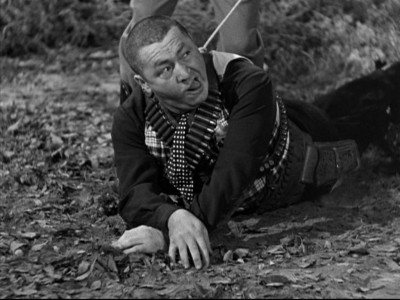
DISC TWO:
1944
Crash Goes the Hash (February 4, 1944)
"After they are mistaken as reporters, the Stooges go undercover as a cook and two butlers to get the scoop on a heiress' engagement to a prince."
Lots of memorable bits and lines from this funny Stooges short that played constantly in syndication. A character breaks the forth wall when he says the boys remind him of The Three Stooges, which causes Curly to snarl, "Hey, that's an insult!" I love the insane scream that parrot gives when Larry knocks him over (and the walking turkey bit is priceless - visible strings and all). Larry's idea of canapés is literally "can of peas"...on a dog biscuit - watch Curly try and eat one. And of course, this is one of those Three Stooges shorts that mothers absolutely hated; once that parrot screeching, "Jeepers, creepers! What a night!" was ingrained into our tiny brains, we'd run around saying it constantly, until Ma blew her top. Sad to see the final appearance of Stooge regular Bud Jamison here.
Busy Buddies (March 18, 1944)
"The Stooges fail miserably as entrepreneurs of the Jive Café, so they decide to enter a local cow-milking contest and milk that opportunity for all it's worth."
The Jive Café sequence is over too quickly before the cow-milking contest comes (the Stooges cooking anything is always funny), which is a bit protracted for the few payoffs it has (although I do love it when first the cow and then the boys are thrown out of the ring). Not an especially memorable Stooges short.
The Yoke's On Me (May 26, 1944)
"This time the Stooges may have bought the farm. Really. But sowing crops is easy compared to what they find in their new barn: escaped Japanese soldiers."
You can start to see, if you look closely, the subtle changes in Curly's performance. In one take he may be fine, such as his funny fan dance here, while another one may find him slightly off-focus or preoccupied. This will continue until If a Body Meets a Body, when the effects of Curly's stroke are clearly shown on camera. Aside from the pumpkin-on-the-window-ledge bit, not much to recommend with this short.
Idle Roomers (July 15, 1944)
"Bellboys Moe, Larry and Curly defy the role of "no flirting" and pay the consequences when the object of their affection's husband brings a wolf man back to their room."
Notable for the introduction of the gorgeous Christine McIntyre, who would soon become a stock Stooges player, and the funny final sequence with Lupe the Wolf Man, who goes absolutely insane when he hears any kind of music - which is exactly what Moe mistakenly has Curly do, play music, to calm him down. I love the unhinged quality of the elevator shot, where they're all jumping up and down in terror, but unfortunately, the structure of the short is shoddy, with not enough of a payoff for this funny premise.
Gents Without Cents (September 22, 1944)
"In this story of hits and Mrs., Moe, Larry and Curly perform their vaudeville act and win over the delighted audience. They also win over three gorgeous dancers."
Thematically one of the more contained later Stooges, with a coherent storyline courtesy of Felix Adler. Notable not only for the snappy version of Three Blind Mice that would be used for future Stooges releases, Gents Without Cents gives a rare big-screen look at the classic vaudeville routine, Slowly I Turn... which the Stooges perform here for the 1943 film, Good Luck, Mr. Yates - a sequence cut from the final print of that film, which was then recycled for this short. It's good to see the boys with a bit of cinematic polish from this period in their career, and they perform the bit flawlessly; Moe, in fact, steals the show with his solid turn (and seriously, what kid in the early '70s didn't do this bit in their living room at one time or another for their friends or parents?).
No Dough Boys (November 24, 1944)
"While on a break from modeling for an ad that has them made up to be Japanese soldiers, the Stooges accidentally stumble into a secret hideout of German spies."
A bizarre Stooges short where the boys are dressed as Japanese spies (looking quite menacing, actually, when they run down the diner owner with knives), which makes little sense, but which gets really weird during the finale when everybody keeps shutting off the lights for blackout comedy. It's a cool effect (I recommend watching it in a lights-out room), with an almost experimental feel to it.

1944
Three Pests in a Mess (January 19, 1945)
"Mistaking the Stooges for sweepstakes winners, a swindler dispatches his lady friend to woo them out of their millions. But she goes "whoa" when she realizes who they really are."
A good "spookem" Stooge short...once it gets going. The lottery ticket angle takes too long to move along (although we get to enjoy beauty Christine McIntyre for a little longer), but once the boys are in the cemetery, the pace quickens.
Booby Dupes (March 17, 1945)
"The Stooges go overboard when their fishing boat starts sinking and they find the airplanes overhead are not rescuers but bombers mistaking their signal for a Japanese flag."
A premise that would have been much funnier just years before with the Stooges, seems a tad tired and rote here, with Curly's diminishing returns become more and more noticeable, affecting the pace and timing of the entire piece. Frequently, the director, Del Lord, has to cutaway from Curly early, snipping the pacing of a sequence to its detriment. The boat sequence is funny - but fairly routine by this point in the Stooges' career.
Idiots Deluxe (July 20, 1945, 1943)
"While out in the country to rest his nerves, Moe cooks a delicious breakfast that gets devoured by a bear. But believing Larry and Curly at it pushes him over the edge."
The last Stooges short before Curly's stroke finds him reduced but trying for the backwoods hijinks here as a bear pretty much steals the show (the bear eating the honey out of the tall jar, where it really has to stick its tongue down in there to get it all out, is as funny a scene as anything else in the picture). It's obvious something is clearly wrong with the star, who evidently was only weeks away from his stroke. The new classical "Comedy" mask front title appear for the Stooges for the first time here. Highlights include Larry and Moe making the most disgusting-looking pieces of bread ever, and the bear signaling a left turn when he drives away in their car.
If a Body Meets a Body (August 30, 1945)
"Where there's a will, there's a way. The Stooges spend the night in a room where someone's been murdered in order to find out how much Curly will inherit from his dead uncle."
The beginning of the end for Curly. If you have trouble spotting the differences in Curly's performances from earlier in the year and turns during his peak years, this short clearly shows the devastating effects of his stroke. It's a painful short to watch, one I don't particularly care for, because ultimately, it turns into a morbid exercise in spotting Curly's illness (slurred speech, pronounced limp, and vacant, unfocused stare). Perhaps as well, Moe's patented vicious attacks on Curly seem merely cruel now, not funny, as the reduced Curly seems more pathetic than anything else.
Micro-Phonies (November 15, 1945)
"When Curly is mistaken for an opera diva, the Stooges find their calling on the stage - then take a stage dive into lunacy and bring a socialite down with them."
Curly rallies, but the film itself is no great shakes, with the potential of Curly in drag as a operatic soprano not realized. The singing by beauty Christine McIntyre, though, is first-rate.
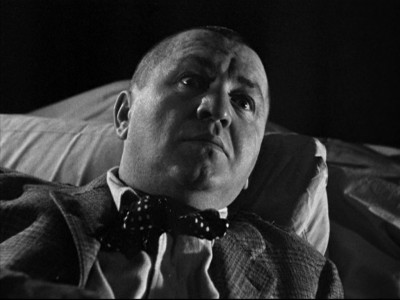
The DVD:
The Video:
There were some problems that I noticed with the full-screen, 1.33:1 video transfers for The Three Stooges Collection - Volume Four: 1943-1945. In the opening short, They Stooge to Conga, there's a few frames missing from a bit where Moe hits Curly in the mouth with a hammer. Dizzy Detectives looked a little rough in spots, as far as excessive grain (all the shorts, to one degree or another, have noticeable grain). And very curiously, Back From the Front and Higher Than a Kite have what I can only assume are compression issues where some of the blacks go green (in Higher just in one brief shot, but in Back for several long ones onboard the ship). This didn't occur with any of the other shorts, which look for the most part, quite good, with super-sharp pictures, good gray scales, and an agreeably bright image.
The Audio:
The Dolby Digital English mono audio track, which mimics the original mix for these shorts' theatrical presentations, is perfectly adequate for the shorts presented here. All dialogue is crisply and cleanly delineated. Subtitles and close-captions are also included.
The Extras:
Regrettably, but not surprisingly considering the first three releases, there are no extras for The Three Stooges Collection - Volume Four: 1943-1945.
Final Thoughts:
The Three Stooges begin The Three Stooges Collection - Volume Four: 1943-1945 collection with their most violent (and certainly one of their funniest) shorts, They Stooge to Conga, and then begin their very slow downward path away from their "Golden Age," until Curly suffers a stroke in 1945. This collection isn't the equal in content of the first three volumes, but there are still many more successful shorts than duds here. Shemp fans take heart: I would imagine the next collection will feature the last Curlys and a few Shemps to cover the transition. Brilliant, surreal physical comedy, where torture and pain are elevated to breathtaking grace. I highly recommend The Three Stooges Collection - Volume Four: 1943-1945.
Paul Mavis is an internationally published film and television historian, a member of the Online Film Critics Society, and the author of The Espionage Filmography.


|
| Popular Reviews |
| Sponsored Links |
|
|
| Sponsored Links |
|
|
| Release List | Reviews | Shop | Newsletter | Forum | DVD Giveaways | Blu-Ray | Advertise |
|
Copyright 2024 DVDTalk.com All Rights Reserved. Legal Info, Privacy Policy, Terms of Use,
Manage Preferences,
Your Privacy Choices | |||||||









